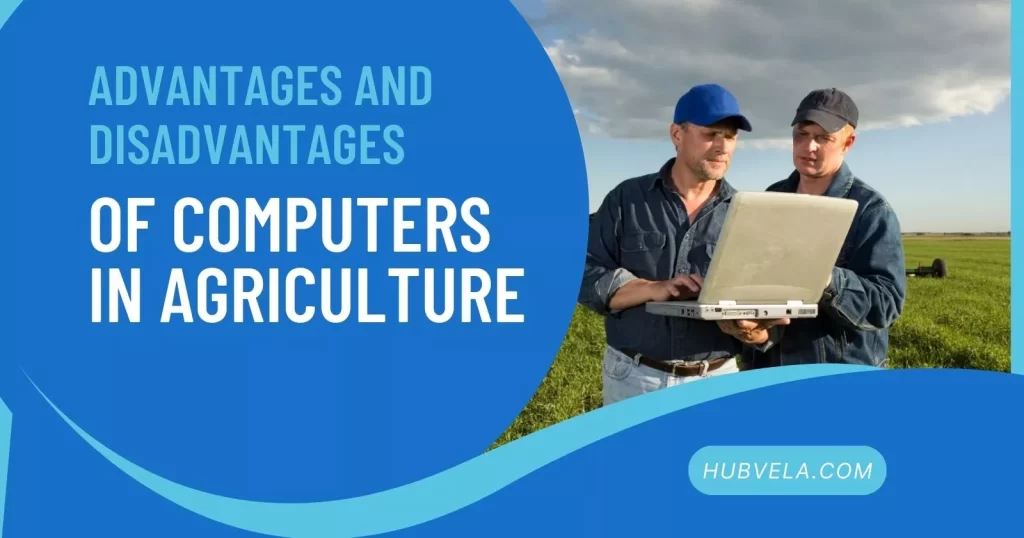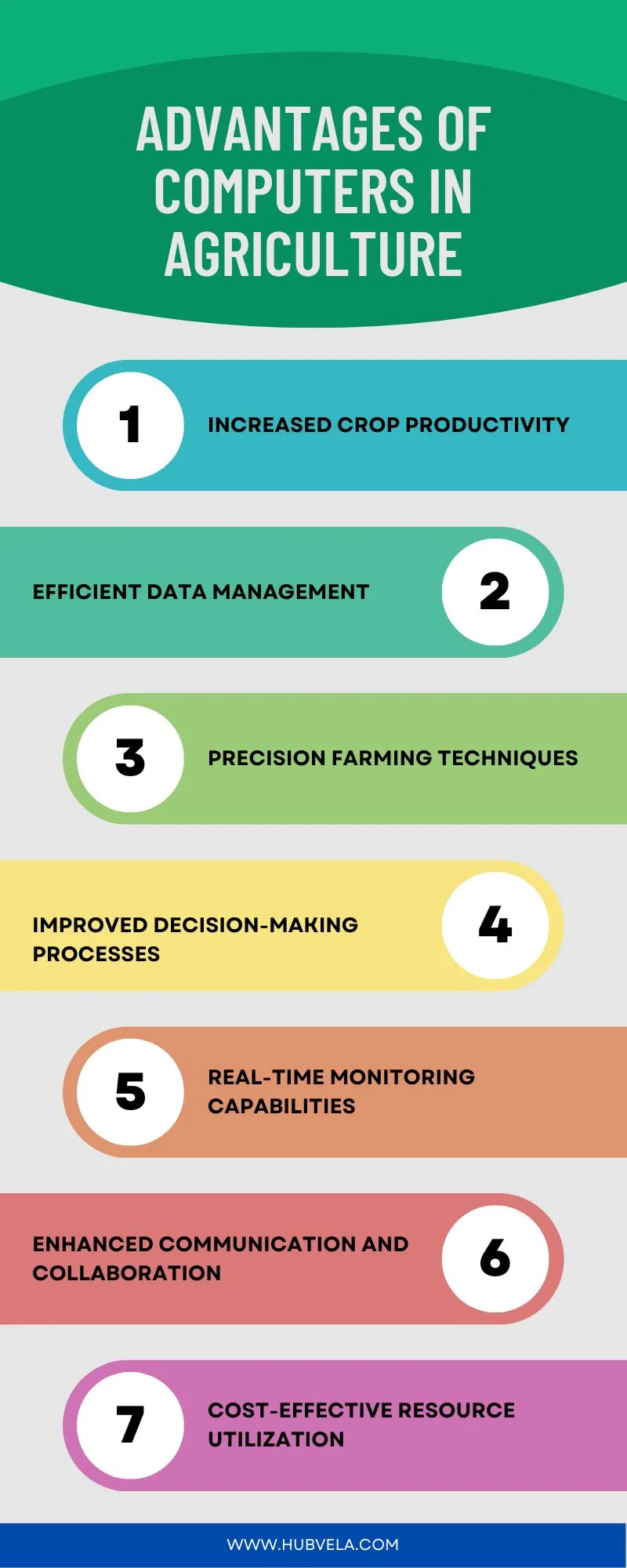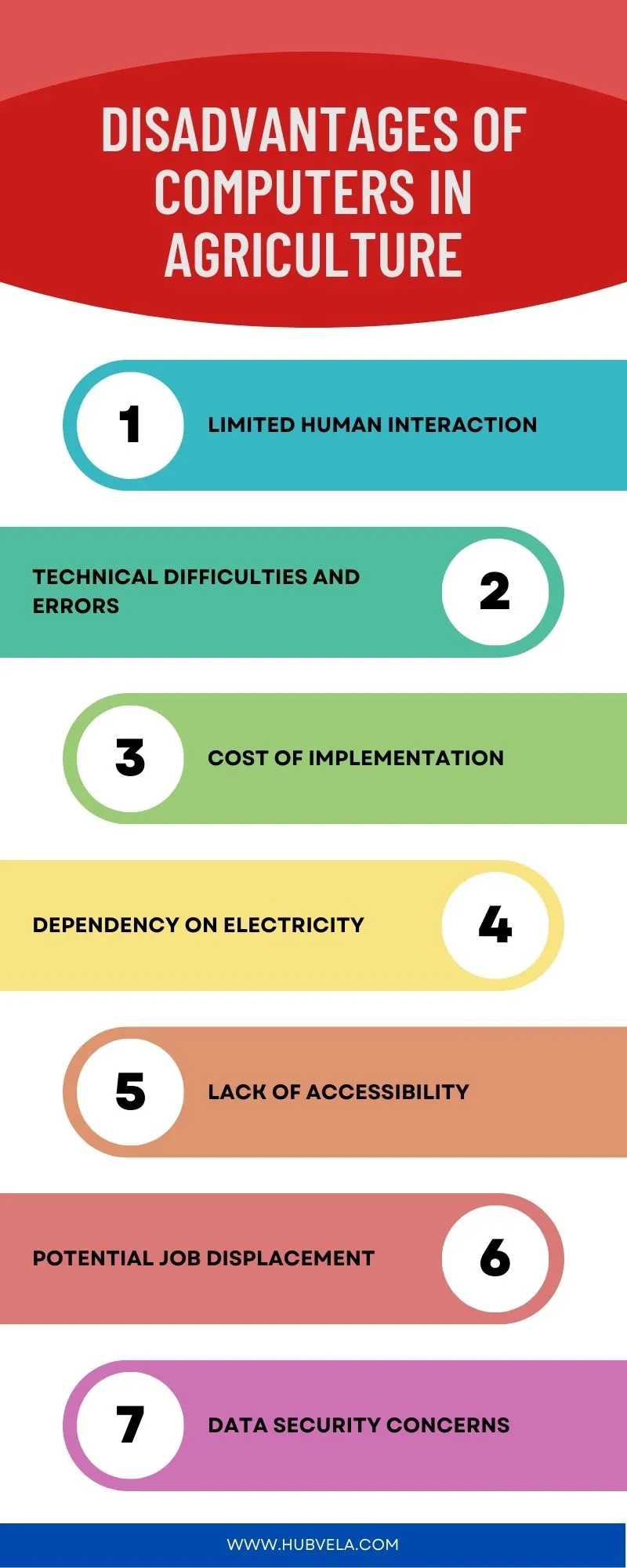You’ve probably heard of the incredible advances in agriculture that computers have been making in recent years. From increasing crop productivity to enhancing data management, computers have a lot to offer the farming industry.
But there are also some potential drawbacks to consider, such as the lack of accessibility to certain areas or the potential for job displacement.
In this article, we’ll explore the advantages and disadvantages of computers in agriculture.

--Advertisement--
Advantages of Computers in Agriculture
In today’s technologically advanced world, computers have become an indispensable tool in various industries, including agriculture.
With the increasing demand for food production and the constant need for efficient farming practices, computers have revolutionized the way agriculture is conducted.
From precision farming to data analysis, the advantages of computers in agriculture are numerous and have significantly contributed to improving productivity, sustainability, and overall success in the field.
We will explore the various advantages that computers bring to the agricultural sector and how they have transformed the way we farm.

1. Increased Crop Productivity
You can increase crop productivity by utilizing computer technology. Sustainable technologies can be used to improve crop yields, and computer systems can help farmers to monitor crop conditions to maximize growth.
By having access to detailed data about soil, water, and climate conditions, farmers can make informed decisions about when and how to irrigate, fertilize, or cultivate their fields. Computer systems can also help farmers to make adjustments to their plans due to climate change.
With computer models, farmers can proactively adjust their crop cycles and techniques to respond to changing weather conditions. By using computer technology, farmers are able to increase the productivity of their crops without sacrificing sustainability.
2. Efficient Data Management
With computerized data management, you can easily keep track of crop yields, soil conditions, and other essential information. Remote monitoring and precision planting technologies allow for more accurate and timely data collection, which can be used to assess the health of soils and crops.
The data collected can be used to optimize irrigation and fertilization, as well as the timing of planting and harvesting. Additionally, with computerized data management, you can easily track and analyze the data over time to identify trends and make more informed decisions.
Computerized data management also allows for more efficient data storage and backup, ensuring that important records don’t get lost. All in all, computerized data management offers a more efficient way to manage agricultural data, making it easier to make informed decisions and keep track of important information.
3. Precision Farming Techniques
One of the biggest advantages of using computer technology in agriculture is its ability to enable precision farming techniques. This involves the use of remote sensing technology to gather data about soil, weather, and pests, and to allow farmers to adjust their practices accordingly.
Automated irrigation systems are also made possible by computer technology, helping farmers to efficiently manage their water resources. With precision farming, farmers are able to make better decisions about the best times to plant, fertilize, and harvest, leading to the most optimal use of resources and fewer crop losses.
Computer technology is also useful for tracking inventory, which helps to reduce waste and ensure that farmers are able to make the most of their land. In addition, computers can provide detailed records of crop yields, helping farmers to accurately assess their progress.
4. Improved Decision-Making Processes
Using computer technology in agriculture can help improve the decision-making process. This allows farmers to more easily adjust their practices to make the best use of resources.
Improved forecasting capabilities enable farmers to make more informed decisions about planting, harvesting, and other management practices. This helps them to plan their operations more efficiently.
Automated irrigation systems are another benefit of computer technology in agriculture. These systems allow for better resource management, reducing water waste and ensuring that crops receive the right amount of water. This helps to optimize yields and reduce water usage.
Computer technology also aids in identifying soil quality issues. By analyzing data collected from sensors and other tools, farmers can identify areas with nutrient deficiencies or other problems. This allows them to take corrective measures to improve soil health and crop performance.
Computer technology also helps farmers develop more comprehensive pest management strategies. By analyzing data on pest populations and weather patterns, farmers can make more targeted and effective decisions about pest control methods.
5. Real-Time Monitoring Capabilities
Computer technology can provide farmers with real-time monitoring capabilities, allowing them to track their crops and soil conditions more closely. Remote tracking systems give farmers the ability to monitor their crops and soil remotely, from their own computers or phones.
Artificial Intelligence can also be used to help farmers monitor their crops, soil, and weather conditions in real-time. AI-based systems can detect and identify any problems with crops or soil, allowing farmers to take quick action if needed.
This real-time monitoring helps farmers stay on top of their crops and soil conditions, and make better decisions on when and how to take action. With AI agriculture, farmers can increase their yields and reduce their costs.
6. Enhanced Communication and Collaboration
You can reap the benefits of improved communication and collaboration with computer technology in agriculture.
Remote sensing and automation technology allow for more efficient communication between farmers, agricultural centers, and other stakeholders. This improved communication can enable more accurate and timely decision-making.
It also allows for more efficient data sharing to help farmers better understand environmental factors and crop growth.
Furthermore, computer technology can be used to collaborate with other farmers and agricultural centers to find the best solutions to common problems. With the ability to interact in real-time, farmers can quickly share best practices and seek guidance from experts.
7. Cost-Effective Resource Utilization
Moving on, computer technology can help farmers to cost-effectively utilize resources. By using investment strategies, such as software that evaluates crop yields and production costs, farmers can reduce overhead and labor costs.
Moreover, computers can be used to track resources, such as machinery, supplies, and labor, allocating them as needed to maximize efficiency and outcome.
Additionally, with the implementation of computers, farmers are able to accurately and quickly monitor changes in weather and climate, allowing them to make real-time decisions to ensure the best results for their crops.
Disadvantages of Computers in Agriculture
In today’s rapidly advancing technological era, computers have become an integral part of various industries, including agriculture.
While computers have undoubtedly revolutionized the way farmers work, there are also several disadvantages associated with their use in agriculture.
We will explore and shed light on some of the key drawbacks that farmers may face when relying heavily on computers in their agricultural practices.
It is important to recognize and understand these disadvantages in order to make informed decisions and mitigate potential challenges in the field of agriculture.

1. Limited Human Interaction
One downside of computers in agriculture is the lack of human interaction. Robotic automation of agricultural tasks can create an impersonal atmosphere which may result in a decrease of morale and motivation.
In addition, with the ever-changing climate, computers can only do so much to adjust to the changing environment. Without the human touch of knowledgeable farmers, it could be difficult to keep up with the demands of climate change in a timely manner.
Furthermore, computers can lack the intuition and creative solutions that humans may be able to provide to a problem. Without the ability to think on their feet, computers are limited in the decisions they can make when it comes to agriculture.
Ultimately, computers are a great asset to agriculture, but their limitations when it comes to human interaction can hinder their effectiveness.
2. Technical Difficulties and Errors
Frequently, computers in agriculture can be plagued with technical difficulties and errors, leading to costly mistakes. Network outages can be a major issue, as it can cause a complete shutdown of the system, hindering the progress of the farm’s operations.
System malfunctions can also occur, leading to inaccurate data and incorrect calculations. This can lead to incorrect decisions being made, damaging the productivity of the farm. Issues can be hard to detect and even harder to fix, leading to further delays and frustration.
To prevent such issues, it’s important to have a reliable and up-to-date system, as well as a backup to avoid major losses.
3. Cost of Implementation
Unfortunately, the cost of implementing computer technologies into agriculture can be quite expensive. From remote access to artificial intelligence, the cost of purchasing or renting hardware and software is often high. Additionally, the cost of training workers on the technologies can add up quickly. In the end, the expenses may be too great for many agricultural businesses, particularly small operations.
Furthermore, the cost of maintenance and repairs can be difficult to budget for. In some cases, computer systems may not perform as expected, leading to costly re-implementation. The cost of computer technologies in agriculture can be daunting, and it’s important to carefully consider if the benefits outweigh the cost of implementation before making a decision.
4. Dependency on Electricity
When it comes to computer usage in agriculture, one of the biggest drawbacks is its reliance on electricity. Power outages can occur due to natural disasters, climate change, or other causes. This can render computer systems useless, leading to costly delays and inefficiencies in agricultural work.
To mitigate the risk of power outages, farmers may need to invest in backup power generators, which can add to the cost of implementing computer technology. Furthermore, in some locations, access to reliable electricity can be a challenge, making it difficult for farmers to benefit from computer technology.
5. Lack of Accessibility
One major disadvantage of computer use in agriculture is the lack of accessibility for many farmers. This is especially true in developing countries, where access to the internet and other technology is limited. Climate change, as well as pest control, mean that farmers in these areas often lack the information they need to make informed decisions. This can make it difficult to take advantage of the advances that computers can provide.
Additionally, the cost of purchasing and maintaining the required technology can be prohibitive for many farmers, making computer use in agriculture an out of reach luxury. Without access, farmers may be unable to take advantage of the opportunities that computer use can provide.
6. Potential Job Displacement
You may be worried that computer use in agriculture will lead to job displacement. In fact, this is a major disadvantage to using computers in the agricultural industry.
Artificial intelligence and other computer technologies can have a major effect on the environment, which may lead to job losses. For example, computer-based irrigation can replace human labor, and automated harvesting machines can increase efficiency and reduce the need for manual labor. This can result in fewer jobs for farmers and agricultural workers.
Additionally, computer-based systems can also help increase crop yields, which can lead to lower prices and decreased demand for agricultural products.
Ultimately, computer use in agriculture can lead to job displacement due to environmental impacts and the introduction of artificial intelligence.
7. Data Security Concerns
Data security is a major concern when it comes to using computers in agriculture. Data privacy can easily be compromised if the computer system isn’t properly secured. Cyber threats such as malware and ransomware can also cause major disruptions in the agricultural sector.
To ensure data security, computer systems must be updated regularly with the latest patches and security protocols. Additionally, it’s important to use strong passwords, encryption, and firewalls to prevent unauthorized access to the system. Having a reliable backup system is also essential to ensure data isn’t lost in case of a cyber attack.
All these measures are necessary to protect data and minimize the risk of data breaches.
Conclusion on Advantages and Disadvantages of Computers in Agriculture
In conclusion, the use of computers in agriculture has both its advantages and disadvantages, and it’s up to the individual to decide which outweighs the other.
Robot farming and artificial intelligence are two main areas where computers have been applied in the agricultural sector, with both positive and negative effects. While robots can reduce human labor, they can also be expensive to maintain and can be vulnerable to breakdowns.
Artificial intelligence can provide useful insights into crop growth, but may also lead to loss of crop diversity if not managed properly.
Ultimately, it’s important to weigh the pros and cons when deciding whether or not to use computers in agriculture.


